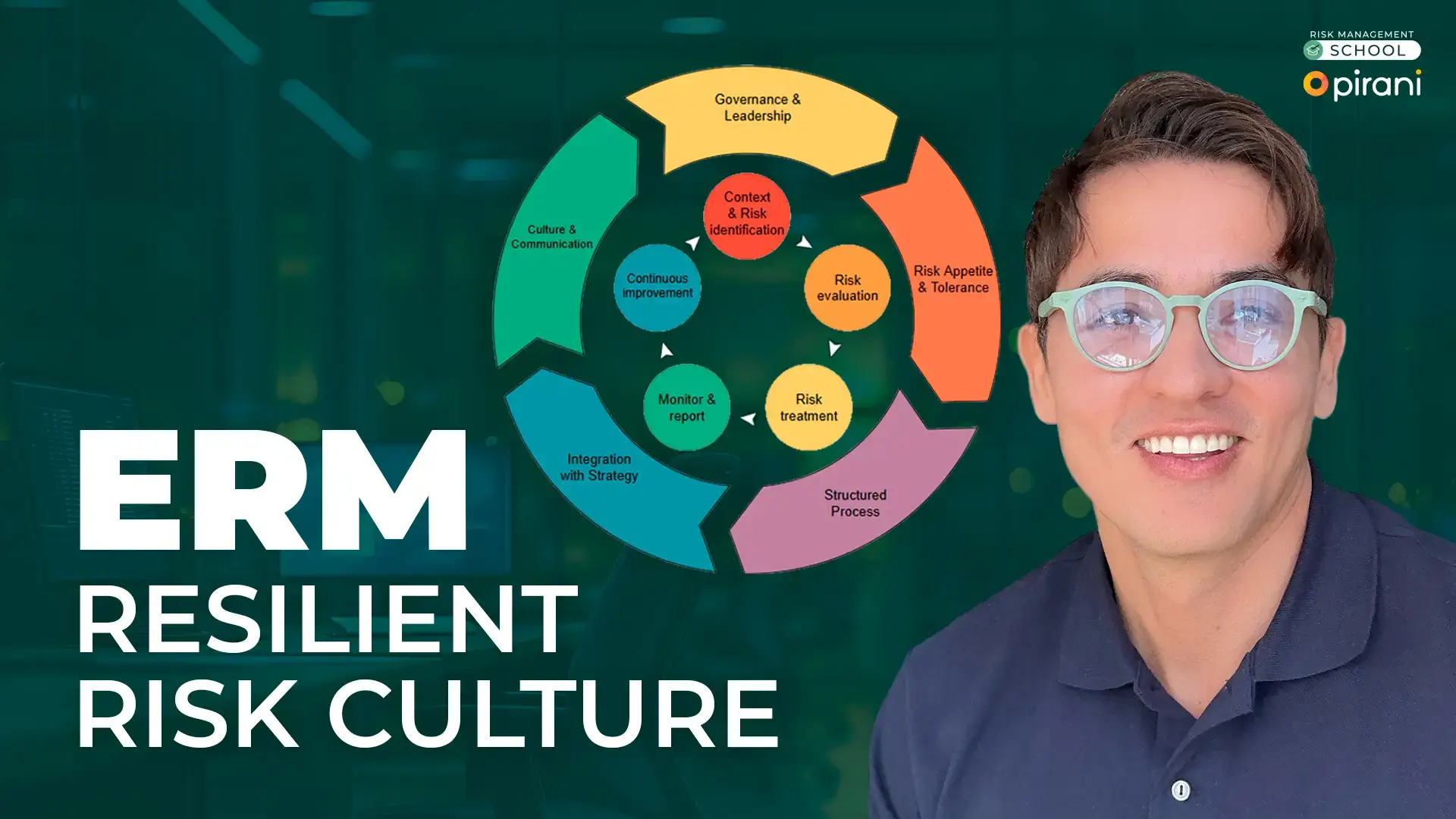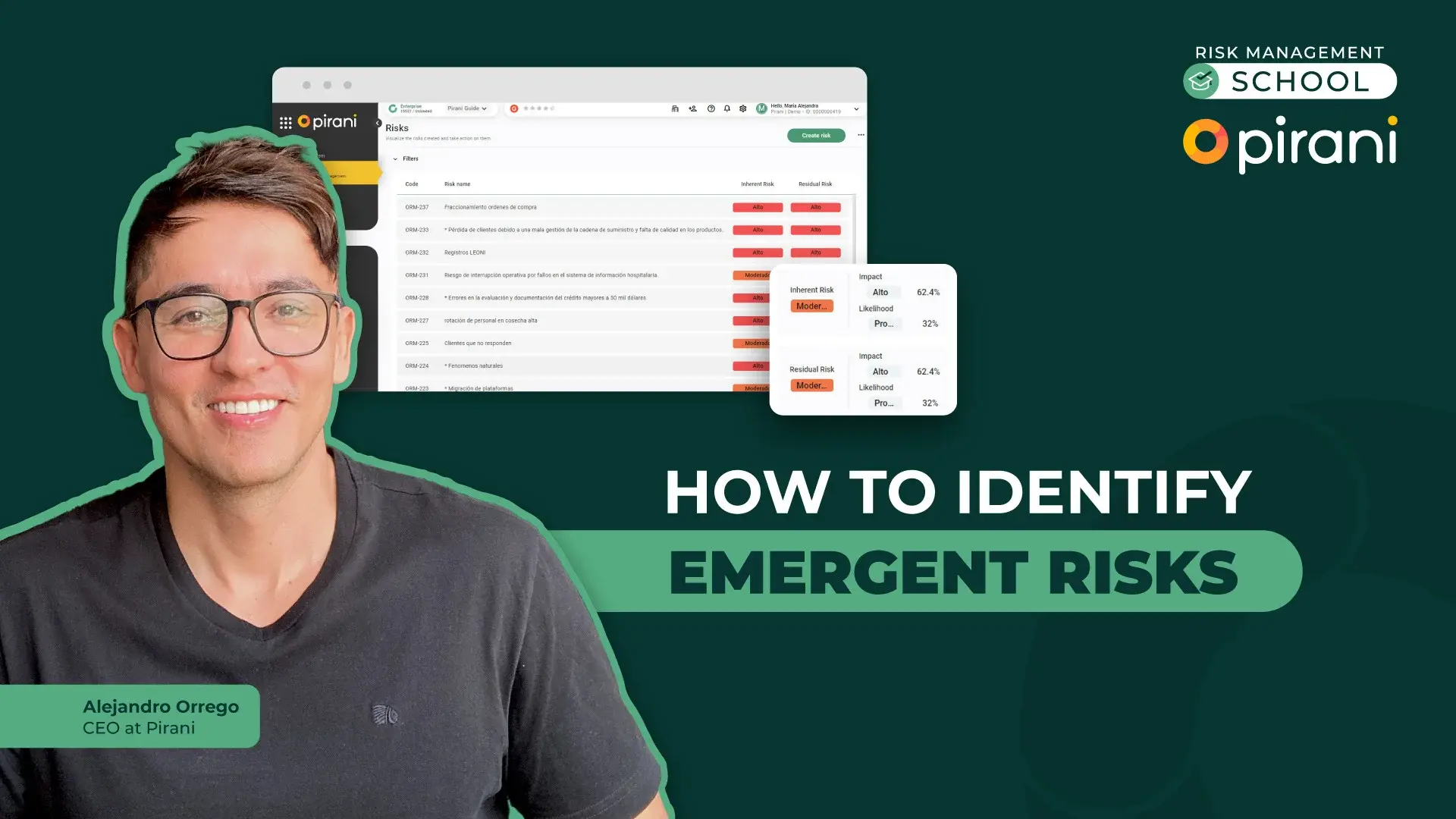[class #4] How to register events for proper risk management
by Risk Management School on 9 de June de 2023
In this session, Alejandro Orrego, CEO of Pirani, teaches us how to monitor risk management, events classification and reporting events.
Events
In the context of risk management, an event is typically defined as a specific incident, occurrence, or circumstance that has the potential to impact an organization's objectives, activities, or projects.
It is an uncertain or unpredictable incident that can be either positive or negative in nature.
“…risk is defined as the effect of uncertainty on objectives.”
A risk refers to the possibility of an event occurring and its potential impact on the objectives of an organization. When an event actually occurs, it represents the realization of that risk.
To better understand this relationship, consider a simple example: A company identifies a risk of a cyber-attack on its computer systems. The event would be the actual occurrence of a cyber-attack, which materializes the identified risk. In this case, the risk is the potential for a cyber-attack, while the event is the actual occurrence of the attack.
Events classification
Events can be classified into various types based on their nature:
- Operational events
(e.g., equipment failure, system malfunction) - Financial events
(e.g., market fluctuations, credit defaults) - Natural events
(e.g., earthquakes, floods) - Human-related events
(e.g., accidents, errors) - Strategic events
(e.g., changes in regulations, competitor actions).
Events are a fundamental component of risk management because they represent the triggers or sources of potential risks.
Identifying, assessing, and managing events allows organizations to proactively address potential risks and take appropriate actions to mitigate their impact or exploit opportunities that arise from positive events.
Reporting events
Reporting events plays a crucial role in fostering a strong risk management culture within an organization. Here are some key aspects of reporting events and its significance:
- Early identification
Reporting events promptly allows for early identification of potential risks. When employees, stakeholders, or other relevant parties report events, it enables the organization to become aware of emerging risks or incidents at an early stage. This timely information can help prevent risks from escalating or causing significant damage. - Information gathering
Reporting events provides an opportunity to gather valuable information about the event itself, its causes, and its potential impact. This information can be analyzed to better understand the underlying risks and their patterns, which helps in developing effective risk mitigation strategies. - Risk assessment and prioritization
By reporting events, organizations can assess and prioritize risks more accurately. The information collected from event reports can be used to evaluate the likelihood and severity of risks, enabling better decision-making when it comes to allocating resources and implementing risk control measures. - Continuous improvement
Event reporting fosters a culture of continuous improvement by promoting learning from incidents. It allows organizations to identify vulnerabilities, weaknesses in processes, or gaps in controls that contributed to the event. This knowledge can be used to implement corrective actions, enhance risk management practices, and prevent similar events in the future. - Compliance and regulatory requirements
In many industries, reporting events is a legal or regulatory requirement. Organizations are obligated to report certain types of events to regulatory authorities or governing bodies. Maintaining a robust event reporting system ensures compliance with these obligations, helping to avoid penalties and reputational damage. - Communication and transparency
Reporting events promotes open communication and transparency within an organization. Employees feel encouraged to report events without fear of reprisal, fostering a culture where risks are openly discussed and addressed. This transparency enables organizations to identify and manage risks more effectively.
Overall, reporting events is essential for creating a proactive risk management culture. It enables organizations to identify, assess, and mitigate risks in a timely manner, driving continuous improvement and better decision-making throughout the organization.
Events priority
- Low
Events with low priority are those that have minimal potential impact or consequences on the organization. These events may have a low likelihood of occurrence, involve relatively small financial or operational implications, and pose a minimal threat to the organization's objectives. While they still need to be monitored and addressed, they can be managed with less immediate attention and resources. - Medium
Medium priority events have a moderate level of potential impact or consequences. They may have a moderate likelihood of occurrence and could result in notable financial or operational implications if they materialize. These events require a reasonable level of attention and resources to assess and address, but they are not as urgent or critical as high priority events.able level of risk mitigation, but periodic evaluations and enhancements may be necessary. - High
High priority events are those with significant potential impact or consequences. They may have a high likelihood of occurrence and can result in substantial financial loss, reputational damage, or disruption to critical operations. These events require immediate attention, swift action, and the allocation of considerable resources to mitigate their potential impact and prevent negative outcomes.
You May Also Like
These Related Stories

Introduction to ERM: Building a Resilient Risk Culture

How to identify emergent risks




No Comments Yet
Let us know what you think